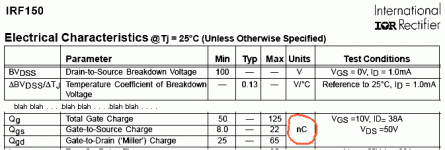After a pretty much continuous series of challenges involving things I know but didn't occur to me to think about I decided to pull out that dusty circuit analysis textbook and get to work. Reading Chapter 2 last night brought the question: Do any EE's (here) actually use the Coulomb in any of their figurings? (or do any of you even remember how many electrons are supposed to be in one? )
I cross the boundary between EE and physics. 1.6 10^(-19)C is etched in my brain, so that means there are about 6 10^18 electrons missing to make a coulomb.
If you need to think about genuine shot noise or partition noise then you will remember that number.
Also, if you want to calculate the ripple in a normal cap input PSU you need to think about coulombs and the definition of capacitance and the definition of current.
So yes, EEs use coulombs all the time.
If you need to think about genuine shot noise or partition noise then you will remember that number.
Also, if you want to calculate the ripple in a normal cap input PSU you need to think about coulombs and the definition of capacitance and the definition of current.
So yes, EEs use coulombs all the time.
The bulb has to want to change first then we can calculate the number.I thought it was going to be How many engineers .... does it take to change a light bulb.....

N I H
None... It wasn't invented here.
-DAAB-
I thought it was going to be How many engineers .... does it take to change a light bulb.....
None... It wasn't invented here.
-DAAB-
Do any EE's (here) actually use the Coulomb in any of their figurings?
Coulomb, aren't those the things that I let out of the wall when I stuck the paper clip into the outlet nearly 60 years ago?
Yes, I use power MOSFET "total gate charge" in my circuit design calculations, several times a week. It's specified right on the datasheets as so-and-so number of nanoCoulombs.
For example I exported Digi-Key's Parametric Search database of MOSFETs to Excel, and then calculated Mark's Figure Of Merit (RdsON * TotalGateCharge) for each row in the spreadsheet, i.e., for each MOSFET. That's how I came to select the NTD4906 MOSFET for my Quasimodo V.4 board; among the tens of thousands of MOSFETs at Digi-Key, that one had the best (lowest) value of (RdsOn * TotalGateCharge). So it gives the fastest possible output edges driving the transformer. BTW Quasimodo V.4's schematics and Gerbers and 20 page Design Note are all freely downloadable here on diyAudio if you are curious.
a few references:
http://www.microsemi.com/document-p...ge-information-in-mosfet-and-igbt-data-sheets
http://www.vishay.com/docs/73217/an608a.pdf
http://www.onsemi.com/pub_link/Collateral/AND9083-D.PDF
http://www.infineon.com/dgdl/an-944.pdf?fileId=5546d462533600a40153559eb9841190
For example I exported Digi-Key's Parametric Search database of MOSFETs to Excel, and then calculated Mark's Figure Of Merit (RdsON * TotalGateCharge) for each row in the spreadsheet, i.e., for each MOSFET. That's how I came to select the NTD4906 MOSFET for my Quasimodo V.4 board; among the tens of thousands of MOSFETs at Digi-Key, that one had the best (lowest) value of (RdsOn * TotalGateCharge). So it gives the fastest possible output edges driving the transformer. BTW Quasimodo V.4's schematics and Gerbers and 20 page Design Note are all freely downloadable here on diyAudio if you are curious.
a few references:
http://www.microsemi.com/document-p...ge-information-in-mosfet-and-igbt-data-sheets
http://www.vishay.com/docs/73217/an608a.pdf
http://www.onsemi.com/pub_link/Collateral/AND9083-D.PDF
http://www.infineon.com/dgdl/an-944.pdf?fileId=5546d462533600a40153559eb9841190
Last edited:
After a pretty much continuous series of challenges involving things I know but didn't occur to me to think about I decided to pull out that dusty circuit analysis textbook and get to work. Reading Chapter 2 last night brought the question: Do any EE's (here) actually use the Coulomb in any of their figurings? (or do any of you even remember how many electrons are supposed to be in one? )
I use it in:
Q=CV=IT
In regards to capacitance, current, time and volts.
- Status
- This old topic is closed. If you want to reopen this topic, contact a moderator using the "Report Post" button.
- Home
- Member Areas
- The Lounge
- How many engineers . . . . . . . . .
